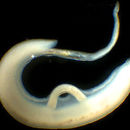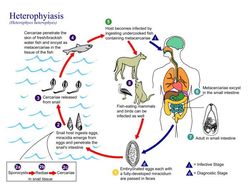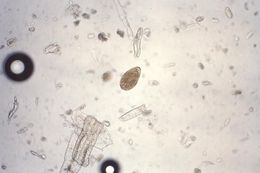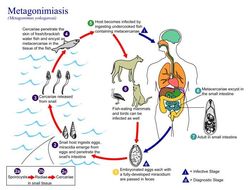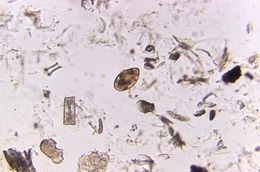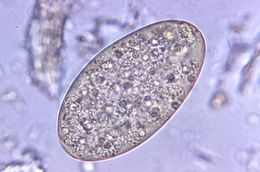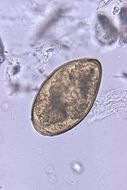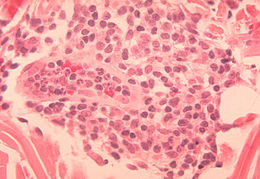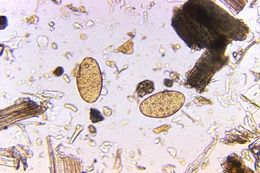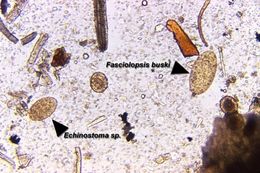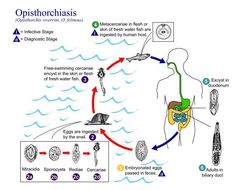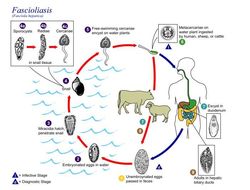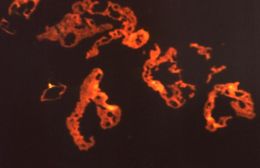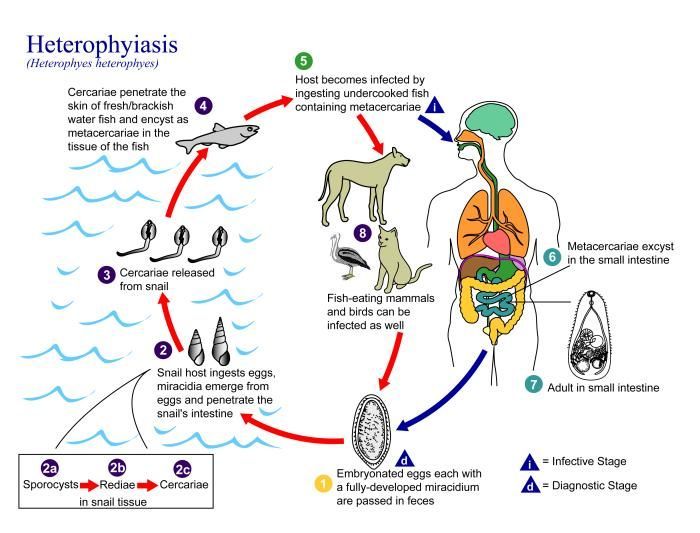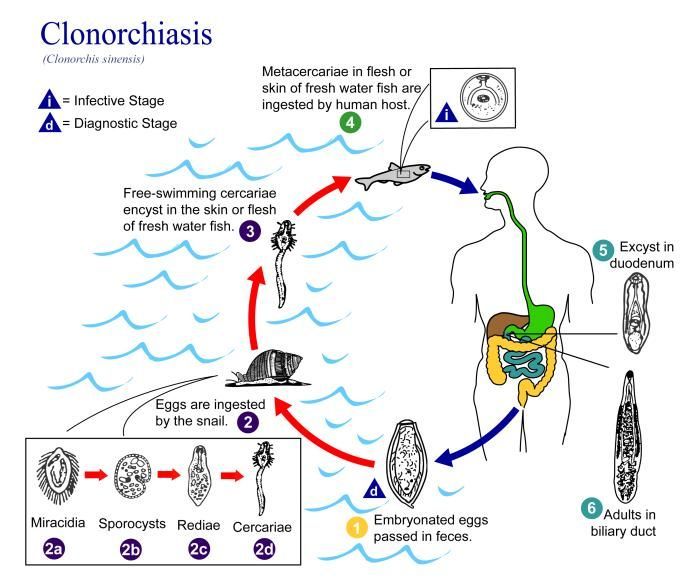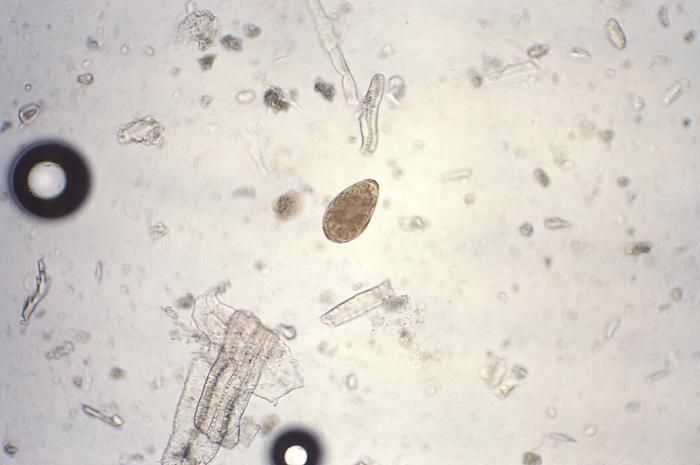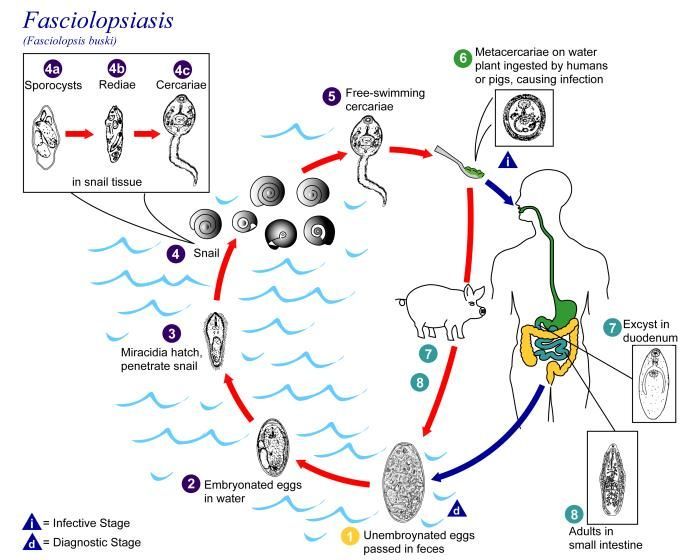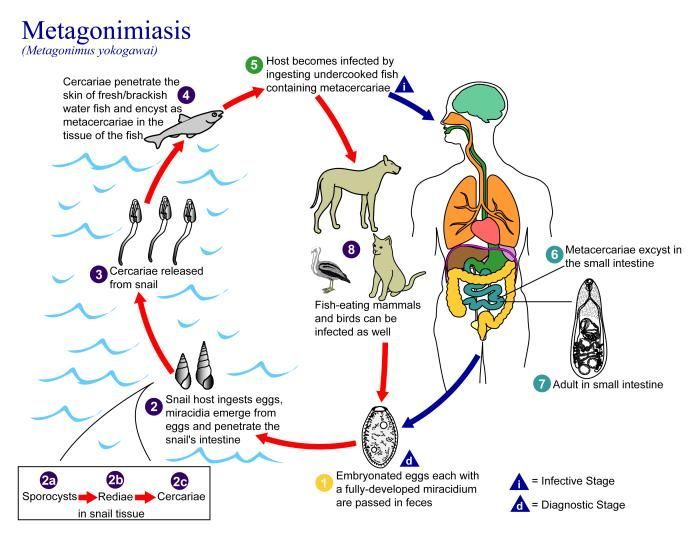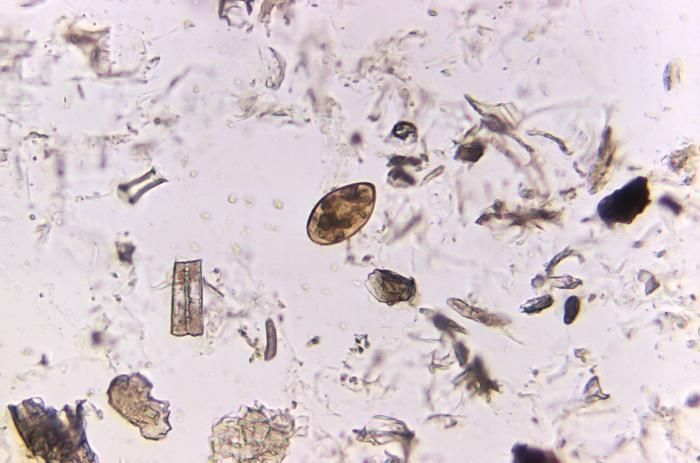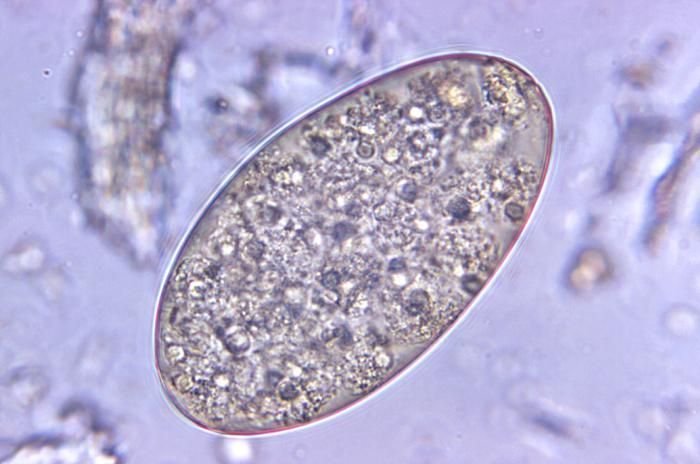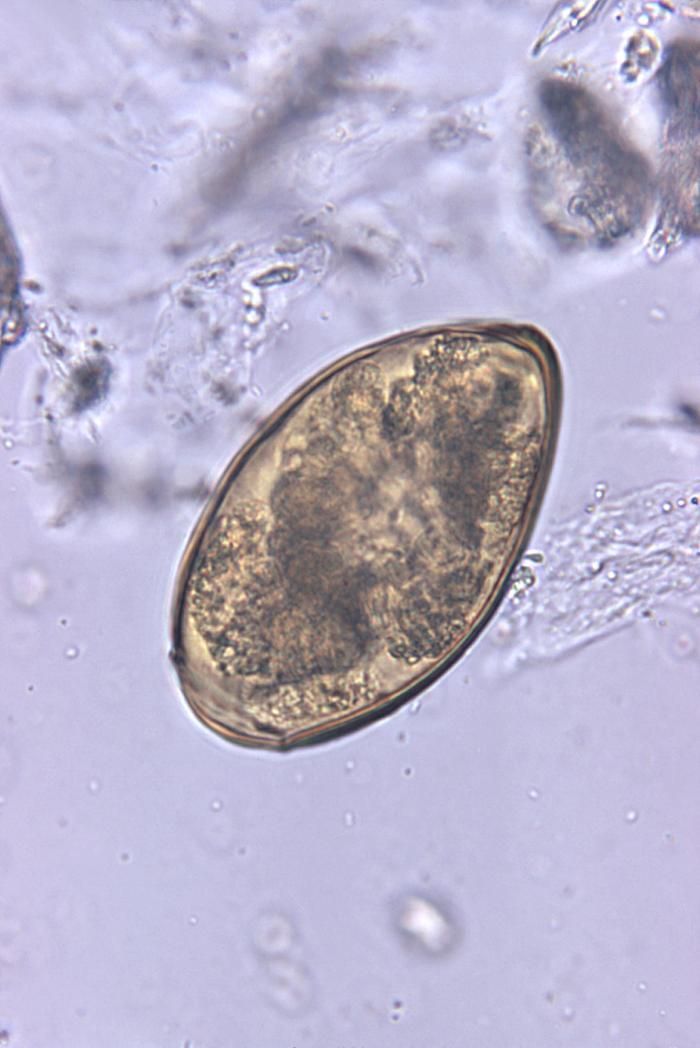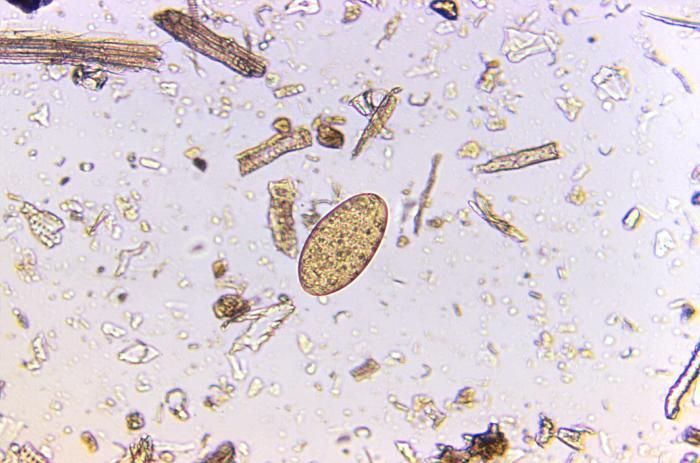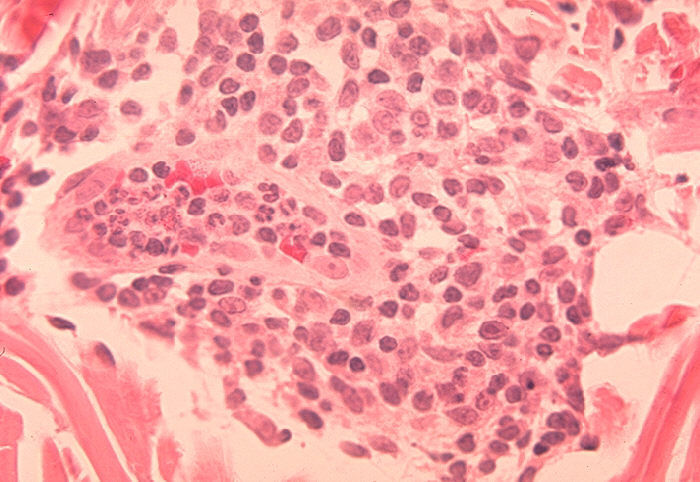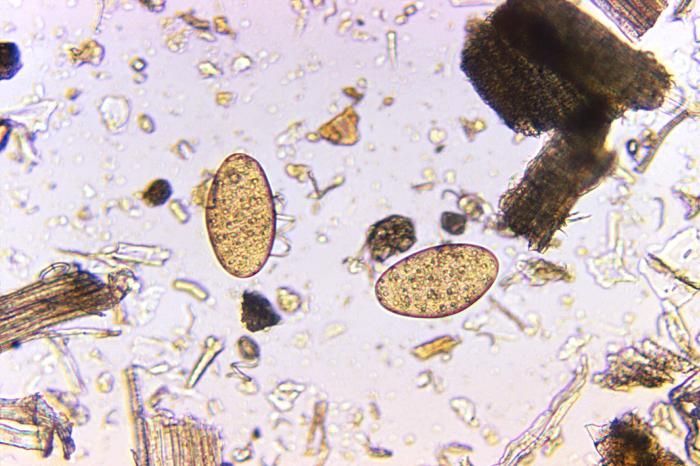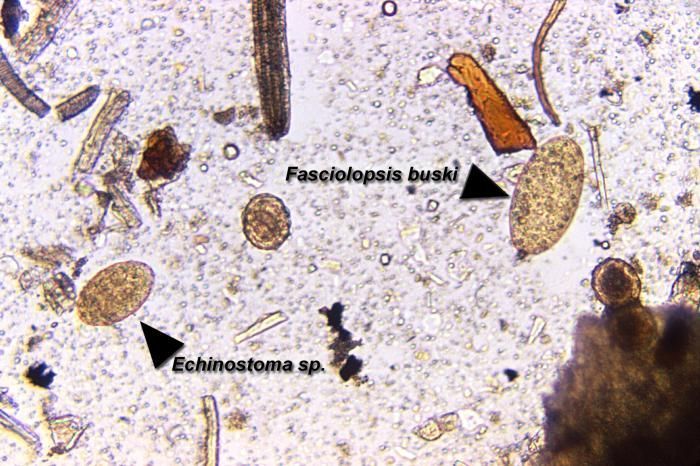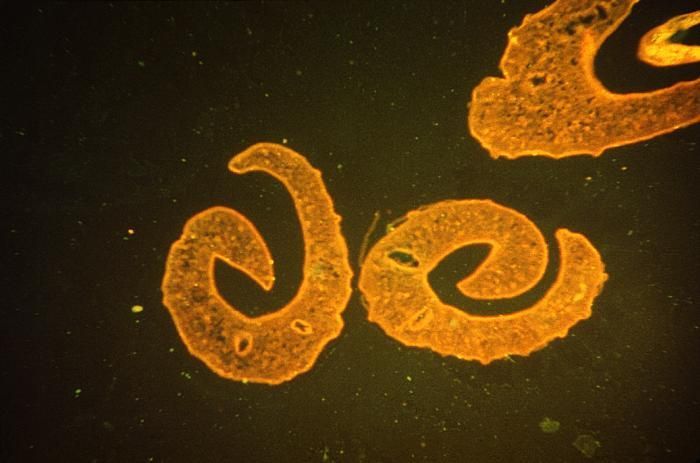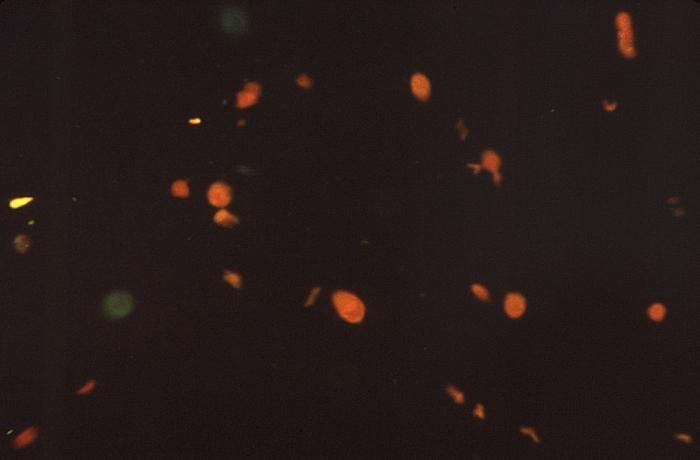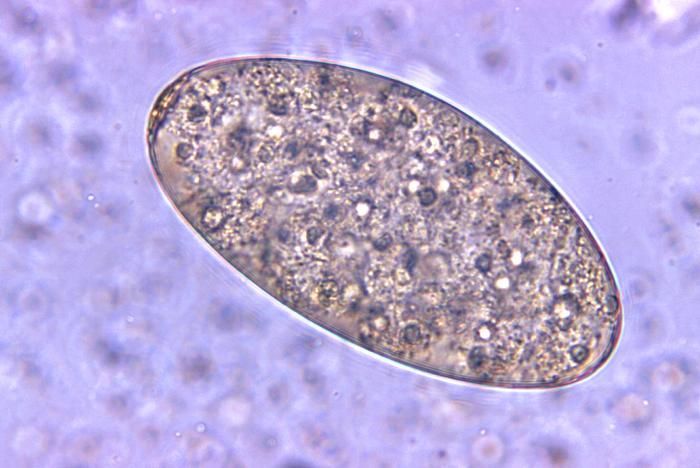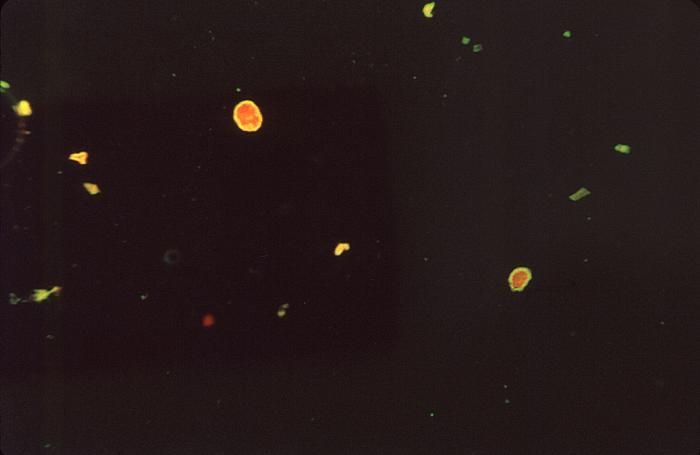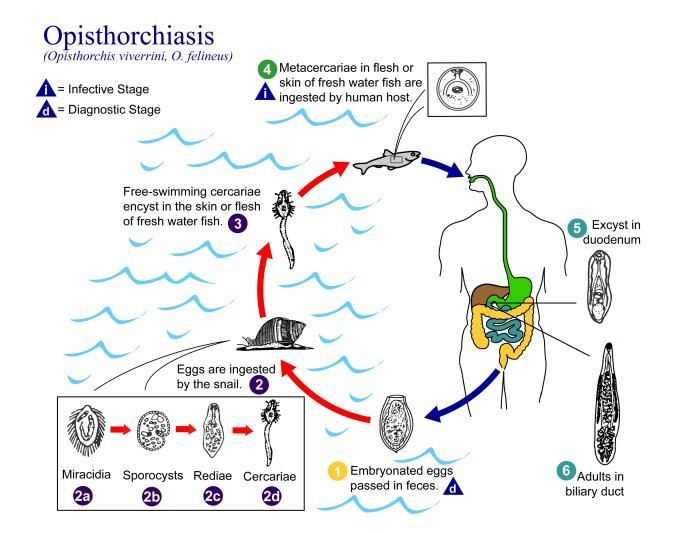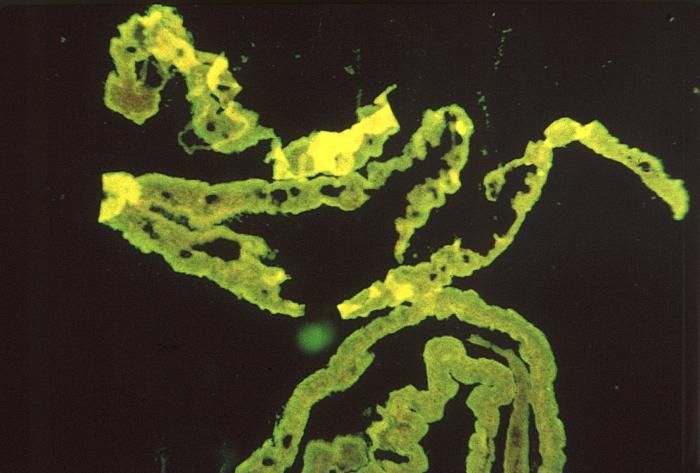-
A Schistosoma mansoni male/female pair. The female is held by the male in a groove along its body.
-
This is an illustration of the life cycle of Paragonimus westermani, one of the causal agents of Paragonimiasis.Created: 2002
-
This is an illustration of the life cycle of Heterophyes heterophyes, the causal agent of Heterophyiasis.Created: 2002
-
This is an illustration of the life cycle of Clonorchis sinensis, the causal agent of Clonorchiasis.Created: 2002
-
Magnified 128X, this photomicrograph revealed some of the ultrastructural morphology of a single trematode Paragonimus westermani egg. P. westermani eggs range from 80µm to 120µm long X 45µm to 70µm wide. They are yellow-brown, ovoid or elongate, with a thick shell, and often asymmetrical with one end slightly flattened. At the large end, the operculum is clearly visible. The opposite (abopercular) end is thickened. The eggs are unembryonated when passed in sputum or feces. See PHIL 1534 for an even closer view of this egg.Created: 1979
-
This is an illustration of the life cycle of Fasciolopsis buski, the causal agent of Fasciolopsiasis.Created: 2002
-
This is an illustration of the life cycle of Metagonimus yokogawai, the causal agent of Metagonimiasis.Created: 2002
-
Magnified 500X, this photomicrograph of an unstained, formalin-preserved stool specimen mount, revealed the presence of a Paragonimus westermani termatode egg. See PHIL 3415 for the depiction of the following life cycle.The eggs are excreted unembryonated in the sputum, or alternately they are swallowed and passed with stool (1). In the external environment, the eggs become embryonated (2), and miracidia hatch and seek the first intermediate host, a snail, and penetrate its soft tissues (3). Miracidia go through several developmental stages inside the snail (4): sporocysts (4a), rediae (4b), with the latter giving rise to many cercariae (4c), which emerge from the snail. The cercariae invade the second intermediate host, a crustacean such as a crab or crayfish, where they encyst and become metacercariae. This is the infective stage for the mammalian host (5).Created: 1973
-
Magnified 500X, this photomicrograph revealed the presence of a Fasciolopsis buski trematode egg that was found in an unstained formalin-preserved stool sample. F. buski are the largest intestinal flukes found parasitizing human beings. These flukes inhabit Asia and the Indian subcontinent, especially in areas where humans raise pigs, and consume freshwater plants.Clinical Features:Most infections are light and asymptomatic. In heavier infections, symptoms include diarrhea, abdominal pain, fever, ascites, anasarca and intestinal obstruction.Laboratory Diagnosis:Microscopic identification of eggs, or more rarely of the adult flukes, in the stool or vomitus is the basis of specific diagnosis. The eggs are indistinguishable from those of Fasciola hepatica.Created: 1973
-
Magnified 500X, this photomicrograph of an unstained, formalin-preserved stool specimen mount, revealed the presence of a Paragonimus westermani termatode egg. See PHIL 3415 for the depiction of the following life cycle.The eggs are excreted unembryonated in the sputum, or alternately they are swallowed and passed with stool (1). In the external environment, the eggs become embryonated (2), and miracidia hatch and seek the first intermediate host, a snail, and penetrate its soft tissues (3). Miracidia go through several developmental stages inside the snail (4): sporocysts (4a), rediae (4b), with the latter giving rise to many cercariae (4c), which emerge from the snail. The cercariae invade the second intermediate host, a crustacean such as a crab or crayfish, where they encyst and become metacercariae. This is the infective stage for the mammalian host (5).Created: 1973
-
Magnified 125X, this photomicrograph revealed the presence of a Fasciolopsis buski trematode egg that was found in an unstained formalin-preserved stool sample. F. buski are the largest intestinal flukes found parasitizing human beings. These flukes inhabit Asia and the Indian subcontinent, especially in areas where humans raise pigs, and consume freshwater plants.Clinical Features:Most infections are light and asymptomatic. In heavier infections, symptoms include diarrhea, abdominal pain, fever, ascites, anasarca and intestinal obstruction.Laboratory Diagnosis:Microscopic identification of eggs, or more rarely of the adult flukes, in the stool or vomitus is the basis of specific diagnosis. The eggs are indistinguishable from those of Fasciola hepatica.Created: 1973
-
Histopathology of delayed hypersensitivity reaction to Schistosoma mansoni antigen.Created: 1972
-
Magnified 125X, this photomicrograph revealed the presence of two Fasciolopsis buski trematode eggs that were found in an unstained formalin-preserved stool sample. F. buski are the largest intestinal flukes found parasitizing human beings. These flukes inhabit Asia and the Indian subcontinent, especially in areas where humans raise pigs, and consume freshwater plants.Clinical Features:Most infections are light and asymptomatic. In heavier infections, symptoms include diarrhea, abdominal pain, fever, ascites, anasarca and intestinal obstruction.Laboratory Diagnosis:Microscopic identification of eggs, or more rarely of the adult flukes, in the stool or vomitus is the basis of specific diagnosis. The eggs are indistinguishable from those of Fasciola hepatica.Created: 1973
-
Histopathology of delayed hypersensitivity reaction to Schistosoma mansoni antigen.Created: 1972
-
Magnified 125X, this photomicrograph revealed the presence of two trematode eggs, a Fasciolopsis buski egg on the right, and an Echinostoma sp. egg seen of the left, which were found in an unstained formalin-preserved stool sample. Note how much larger the F. buski is compared to that of the Echinostoma sp. egg. F. buski trematodes are the largest intestinal flukes found parasitizing human beings. These flukes inhabit Asia and the Indian subcontinent, especially in areas where humans raise pigs, and consume freshwater plants.Created: 1973
-
Under a low magnification of 78X, and stained using an indirect fluorescent antibody (IFA) test, this photomicrograph confirmed the presence of Schistosoma mansoni trematodes.Laboratory Diagnosis for Schistosomiasis:Microscopic identification of eggs in stool or urine is the most practical method for diagnosis. Stool examination should be performed when infection with S. mansoni or S. japonicum is suspected, and urine examination should be performed if S. haematobium is suspected. Eggs can be present in the stool in infections with all Schistosoma species. The examination can be performed on a simple smear (1 to 2 mg of fecal material).Created: 1972
-
Magnified 125X, at its center, this photomicrograph revealed the presence of a Fasciolopsis buski trematode egg found in an unstained formalin-preserved stool sample. F. buski are the largest intestinal flukes found parasitizing human beings. These flukes inhabit Asia and the Indian subcontinent, especially in areas where humans raise pigs, and consume freshwater plants.Created: 1972
-
Under a low magnification of 78X, and stained using an indirect fluorescent antibody (IFA) test, this photomicrograph confirmed the presence of Schistosoma mansoni trematodes.Laboratory Diagnosis for Schistosomiasis:Microscopic identification of eggs in stool or urine is the most practical method for diagnosis. Stool examination should be performed when infection with S. mansoni or S. japonicum is suspected, and urine examination should be performed if S. haematobium is suspected. Eggs can be present in the stool in infections with all Schistosoma species. The examination can be performed on a simple smear (1 to 2 mg of fecal material).Created: 1972
-
Magnified 500X, this photomicrograph revealed the presence of a Fasciolopsis buski trematode egg found in an unstained formalin-preserved stool sample. F. buski are the largest intestinal flukes found parasitizing human beings. These flukes inhabit Asia and the Indian subcontinent, especially in areas where humans raise pigs, and consume freshwater plants.Created: 1973
-
Under a low magnification of 78X, and stained using an indirect fluorescent antibody (IFA) test, this photomicrograph confirmed the presence of Schistosoma mansoni trematodes.Laboratory Diagnosis for Schistosomiasis:Microscopic identification of eggs in stool or urine is the most practical method for diagnosis. Stool examination should be performed when infection with S. mansoni or S. japonicum is suspected, and urine examination should be performed if S. haematobium is suspected. Eggs can be present in the stool in infections with all Schistosoma species. The examination can be performed on a simple smear (1 to 2 mg of fecal material).Created: 1972
-
This illustration shows the life cycle of Opisthorchis felineus and O. viverrini, responsible for Opisthorchiasis.Created: 2002
-
Under a low magnification of 78X, and stained using an indirect fluorescent antibody (IFA) test, this photomicrograph confirmed the presence of Schistosoma mansoni trematodes.Laboratory Diagnosis for Schistosomiasis:Microscopic identification of eggs in stool or urine is the most practical method for diagnosis. Stool examination should be performed when infection with S. mansoni or S. japonicum is suspected, and urine examination should be performed if S. haematobium is suspected. Eggs can be present in the stool in infections with all Schistosoma species. The examination can be performed on a simple smear (1 to 2 mg of fecal material).Created: 1972
-
This is an illustration of the life cycle of the causal agents of Fascioliasis.Created: 2002
-
Under a low magnification of 78X, and stained using an indirect fluorescent antibody (IFA) test, this photomicrograph confirmed the presence of Schistosoma mansoni trematodes.Laboratory Diagnosis for Schistosomiasis:Microscopic identification of eggs in stool or urine is the most practical method for diagnosis. Stool examination should be performed when infection with S. mansoni or S. japonicum is suspected, and urine examination should be performed if S. haematobium is suspected. Eggs can be present in the stool in infections with all Schistosoma species. The examination can be performed on a simple smear (1 to 2 mg of fecal material).Created: 1972

